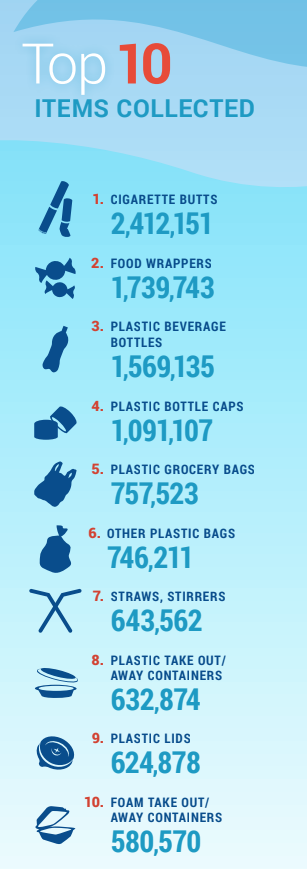Making history, in a bad way

For the first time in the more than 30-year history of the International Coastal Cleanup, the top 10 most common trash items collected in 2017 were ALL PLASTIC. According to an Ocean Conservancy report released today, this is likely the beginning of a long trend. This result is not surprising, given the rampant increase in plastic production and the massive amount of it that enters the ocean each year. In the recent documentary “The Smog of the Sea”, marine scientist Marcus Eriksen poignantly points out that plastic trash, especially the tiny plastic fragments called microplastics, will be “the fossils of our time”. Plastic fragments have already been found in the sediments of the ocean and land all over the world. These plastic fragments will not be broken down by natural processes, forming an indelible layer of trash fossils that will define our current epoch. Depressing? Yes! But what is inspiring is that we can change how deep that layer gets. There are broad-scale improvements to garbage collection and recycling that need to occur globally. But…
There are lots of simple actions you can take today to make a difference!
What you can do?
- REFUSE single-use plastics. We should do away with the notion that plastic is “disposable” because plastics take a very long time to degrade. Some of the most common plastic items found in the ocean are plastic bags, plastic caps and lids, plastic drinking straws, and plastic beverage bottles. You can really cut down on plastic use by bringing your own cloth bags to the grocery store, purchasing items packaged in paper or glass whenever possible, using a refillable metal or glass water bottle, and stopping your use of plastic drinking straws.
- Recycle. Of course, you should recycle whenever possible but recycling is not a true solution to plastic pollution in the ocean. Many items are not recyclable and recycling is not 100% efficient. Focus on limiting plastic use first, and recycle when you can’t avoid using plastic.
- Limit sources of microplastics. Purchase personal care products that do not contain polyethylene. Stick to natural fabrics, as synthetic fibers are some of the most common types of microplastic found in Florida’s waters.
 Be a responsible angler. Recycle your used monofilament in a specially designed monofilament recycling bin. Monofilament can’t be recycled in regular recycling bins. Many boat ramps and fishing piers offer special PVC monofilament recycling bins.
Be a responsible angler. Recycle your used monofilament in a specially designed monofilament recycling bin. Monofilament can’t be recycled in regular recycling bins. Many boat ramps and fishing piers offer special PVC monofilament recycling bins.- Participate in marine cleanup events. Many coastal communities host clean-ups you can take part in, including the 2018 Cedar Key International Coastal Cleanup. Or, gather some friends and start your own shoreline cleanup!
- Pledge to make a change. You can take the pledge to reduce your plastic use or accept the challenge for a plastic free July!
- Join a movement. Organizations like Zero Waste Gainesville are working to make changes in local communities. You can join a similar local in your community or join a global movement like the Strawless Ocean or the Last Plastic Straw.

Other Resources:
The Florida Microplastics Awareness Project
Florida Microplastics Fact Sheet (pdf)
Five Tips for Keeping Beaches Clean from UF/IFAS Sea Grant Agent Maia Mcguire
NOAA Blog Post about the Florida Microplastics Awareness Project
NOAA Blog Post about Ways You Can Keep Plastic Out of the Ocean
 0
0
 Be a responsible angler. Recycle your used monofilament in a specially designed monofilament recycling bin. Monofilament can’t be recycled in regular recycling bins. Many boat ramps and fishing piers offer special PVC monofilament recycling bins.
Be a responsible angler. Recycle your used monofilament in a specially designed monofilament recycling bin. Monofilament can’t be recycled in regular recycling bins. Many boat ramps and fishing piers offer special PVC monofilament recycling bins.